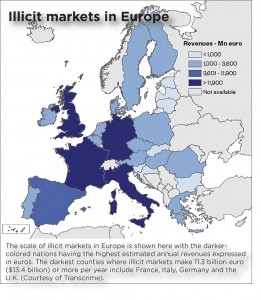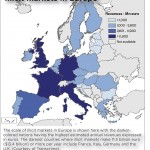Organized crime in Europe major contributor to $120 billion per year in illicit rackets

European Union-funded study outlines illegal markets infiltrated by thirty-five organized crime group
The first of three parts on the state of organized crime in Europe
Russian/Georgian, Italian and Chinese organized crime syndicates, motorcycle gangs and criminal groups of British, Dutch and Turkish origin are involved in the highest number of illicit markets in Europe, where revenues from criminal enterprises amount to at least $120 billion a year, according to a new study of organized crime throughout Europe.
The 341-page report, released in April, is titled “From Illegal Markets to Legitimate Businesses: the Portfolio of Organized Crime in Europe,” (or Project OCP), and funded by the EU. It was coordinated by the Joint Research Center of Transnational Crime in Trento, Italy, in partnership with law enforcement authorities in the countries participating in the study: Finland, France, Ireland, Italy, the Netherlands, Spain and the United Kingdom.
The report’s authors called it the “first exploration of the economics of organized crime in Europe” at a time when the European Parliament has introduced new policy measures to confiscate and recover criminal assets and combat money laundering by criminal organizations. Using what they described as a “pioneering analysis” to address the general lack of knowledge of organized crime in Europe, the authors sought to identify the main illicit markets that organized criminals use to obtain their money, the legitimate businesses they invest in and how much of the proceeds are recovered and confiscated by authorities.
In the twenty-eight countries of the EU, the illicit markets together generate about $120 billion a year, a figure that likely is underestimated, the study found. The annual take from drug trafficking alone was estimated at $31.6 billion, but might be far higher. Also of concern is the criminal market for Value Added Tax fraud – the non-payment of VAT taxes from the sales of the goods within the EU – which amounts to about $32.7 billion in government tax losses a year.
The report found that thirty-five organized crime groups are operating in Europe, and that nearly all of the EU nations had been infiltrated.
The top illegal enterprises analyzed in depth in the study include the dealing of heroin, cocaine, cannabis, amphetamines, ecstasy, trafficking in human beings, illegal trading of cigarettes, production and sales of counterfeit products, tax fraud and property crimes such as cargo theft.
Based on estimates from varying sources, among the seven countries studied Project OCP showed that revenues from organized crime based in the U.K. were estimated at $36 billion and France at up to $23 billion. Revenues from organized crime in Germany, not taking part in the study, were estimated to be $19.3 billion.
In Italy, point of origin for traditional Mafia groups such as the Camorra and ‘Ndrangheta families, illegal proceeds were put within a broad range of $32 billion to more than $60 billion, because of the plethora of research on its organized crime compared with other nations. The billions from criminal activities included in Italy’s total – such as drug smuggling, illegal gambling and extortion/racketeering – dwarfed the other six countries chosen for Project OCP.
Outside of illicit markets such as drugs and human trafficking, organized crime in Europe has infiltrated legitimate businesses used both for income and laundering money from illegal activities, the study found. Those business are primarily bars and restaurants, construction firms, food, clothing and other wholesale and retail trade products, transportation, hotels and real estate.
Russian/Georgian organized crime groups are in the largest number of the EU nations, mainly investing their criminal profits in wholesale and retail businesses, bars and restaurants, real estate, hotels and casinos. Chinese organized crime groups, including those sending illicit proceeds back to mainland China, are highly involved in wholesale and retail markets – such as those dealing in counterfeit goods including DVDs and other digital piracy — bars and restaurants, massage parlors and money transferring. Italy’s Camorra and ‘Ndrangheta were frequently identified in illicit markets outside Italy. Other crime groups with significant holdings in Europe originated in the U.K., the Netherlands and Turkey.
In the seven countries the report focuses on, money from organized crime is invested primarily in areas with the highest concentration of crime groups, such as southern Italy; those areas offering the best access to the European mainland for trafficking illegal goods, such as the autonomous region of Andalusia in southern Spain; strategic shipping ports and airports such as in Amsterdam and Rotterdam in the Netherlands; border regions such as northwestern Italy and southwestern France; tourist-heavy areas including Provence-Alps-Cote d’ Azur in France, and major cities such as Rome, Madrid, London, Berlin and Bucharest.
The report cites a number of emerging trends among Europe’s organized criminal groups, which typically move across borders and rarely stay only in their countries of origin. Many groups are shifting from traditional markets toward lower-risk, higher-reward activities such as synthetic drugs (i.e., methamphetamines) and indoor-grown cannabis; credit card fraud; organized property crimes such as the sale of stolen medicines; cars and car parts; tobacco smuggling and firearms trafficking. Other businesses that have been infiltrated recently by organized crime in Europe include renewable energy and waste management.
Feedback or questions? Email blog@themobmuseum.org







